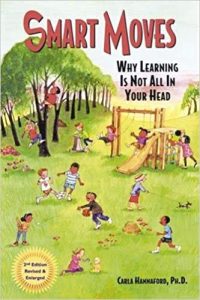Does Your Child Have Sensory Processing Problems?
Some children are completely overwhelmed by sensory input. They may not be able to organize thought and react as a situation requires; others may not notice or comprehend enough of the information present in order to interact appropriately. It’s possible that you have regularly experienced your child exhibiting similar sensory overload issues, and you may have started to grow concerned about their symptoms. Other parents may be worried that their child does not feel the appropriate amount of pain to be able to announce that they have an aching tooth or an ear infection. It is only in retrospect that the parent may learn about the child’s health issue, simply because they had an annual exam scheduled with their pediatrician.

Book on Sensory Processing by Carla Hannaford, Ph.D.
Dr. Alfred Tomatis’s work is discussed under the sense of hearing.
Your child may be very sensitive to sensory stimulation—for example, they may not like to be touched, dislike certain textures, and are uncomfortable with having their teeth or hair brushed. They may also not enjoy swings, slides, or anything else that accelerates. This may even extend to sports and play, where the amount of stimuli can often be overwhelming.
Alternatively, your child may not register and adjust to the information provided by their senses. For example, a child who doesn’t register pain may press too hard when writing, therefore fatiguing sooner than the peers. Or, perhaps the child has little or no response to a stimulus that would normally illicit one, such as pain from a toothache.
Children with sensory processing issues can often be easily distracted when too much information is present. It is easy for them to be overwhelmed, and they may need frequent breaks to cope. Similarly, noticing less information than necessary leads to a sense of being out of sync with the other children and the situation at hand. This can be frustrating for both the child—who likely just wants to experience situations with the ease of their peers—and the parent—who is likely worried about their child’s quality of life.
You May Wonder: How Common is Sensory Processing Disorder?
About 1 in 20 children will struggle with some sort of sensory processing issue. They may present as other diagnoses—such as ADHD—and so many times these issues may go undiagnosed or unaddressed. Sensory processing disorder symptoms can include, among other issues, fatigue when exposed to too much information, sensitivity to light and sound, and dislike of certain clothing textures or vestibular sensitivity.
While the exact cause of sensory processing disorder is unknown, the fact is that encouraging children and exposing them to play outside (especially in their early years) is a powerful avenue to prevent sensory processing disorder from taking a grasp on your child’s life. Creating the opportunity to experience a wide variety of sensory input in a natural manner is one of the efficacious paths in helping their central nervous system to learn about, regulate and organize sensory-input.
However, if you child presents with sensory processing issues, that doesn’t mean that your child can not improve in his or her ability to process information. The brain is exceptionally receptive to change at any age, and in particular when young. This means that it’s possible to help a child adapt and better process sensory information in a way that’s not overwhelming for them.
Auditory Intervention Can Be A Useful Sensory Processing Disorder Treatment
Many parents will take their children to traditional therapies to address sensory processing problems. While helpful, traditional therapy is only a part of the answer, as it can be a number of years of intervention before the child and parents may see the full-expected changes. By using the Tomatis method, a highly concentrated sound stimulation program, it allows the treatment to yield more rapid results. Additionally, it also allows time for real world practice between the intense phases to optimize the skills being worked on.
The first and most important step would be to provide an assessment for your child. This will allow us to determine whether sensory processing disorder is really the issue or if it’s something else entirely. Once we know the core of the problem and how it relates to your child’s processing capabilities, I will create a tailor-made treatment plan specifically for your child’s unique situation.
 Much of our auditory stimulation program for this disorder involves engaging the regulatory mechanisms as we help him or her desensitize. In other cases, we will help them become aware of certain stimuli. For example, if a child is incredibly sensitive to loud noises, we would create a program that would help train their self-regulatory mechanisms to reduce their discomfort. Additionally, we will address the emotional regulation mechanisms in consulting with the child/parents. On an individual basis we will also include or recommend other interventions/experts that may speed up the process, depending on the degree of the disorder.
Much of our auditory stimulation program for this disorder involves engaging the regulatory mechanisms as we help him or her desensitize. In other cases, we will help them become aware of certain stimuli. For example, if a child is incredibly sensitive to loud noises, we would create a program that would help train their self-regulatory mechanisms to reduce their discomfort. Additionally, we will address the emotional regulation mechanisms in consulting with the child/parents. On an individual basis we will also include or recommend other interventions/experts that may speed up the process, depending on the degree of the disorder.
It is absolutely important to involve the parents in this process, and so we typically invite them to be part of the program; parents learn how to support their child outside of our sessions. We also offer strategies/consulting for how teachers can better help a child who is struggling with sensory problems.
I have been providing sensory processing disorder treatment for over 25 years. This began when I worked in the Neuropediatric Clinic in Hamburg, Germany, under Dr. Inge Flehmig, MD (neuro-pediatrician), who trained me in Sensory Integration. As a senior therapist at the clinic I provided sensory-integration treatment to individual and small groups of children/teenagers. Concomitantly, I have tested many of these children with psychoeducational tests and followed with recommendations for their school to provide accommodations for their specific SI challenges. In addition, Dr. Flehmig also led a Professional Training Institute, where I was part of the faculty. From this unique expertise, I taught pediatricians, OTs, PTs and psychologists and teachers a variety of techniques for addressing or treating sensory processing challenges.
While sensory processing issues can be very frustrating for all involved, they don’t have to continue to interfere with your child’s quality of life. The brain can be trained and, with systematic sound training, can be taught to process information more readily and accurately, leading your child to their full potential.
You may still have reservations about auditory intervention as a sensory processing disorder treatment…
How can the brain actually change?
The brain is very plastic (malleable), especially when still young. This is because the mind needs to be able to adapt to a variety of sensations to better prepare the child for the adult world. Even as an adult, the brain can be receptive to change. In fact, one study showed that music helped change the brain in professional musicians and their audiences.
I’m worried the program will be too intensive for my child.
Our program has built-in breaks between the sessions to allow children to adapt and learn while putting into practice any advice that we may give. This means that, even though the program is still highly concentrated, it feels less intense than it would otherwise.
How different is this from normal therapy?
While both forms of intervention can be helpful, the Tomatis method is unique since it addresses the root of the problem and therefore maturity of the various sensory systems can be sooner optimized. Additionally, you can use it to supplement traditional therapy, which can help the overall process be even more successful.
Sensory Processing Disorder Treatment Can Improve Your Child’s Quality of Life
If you have any questions, I offer a free phone consultation at 206-522-8873. Additionally, I offer free monthly, in-person presentations where you can learn more about auditory intervention. Whenever you are ready to discuss your child’s symptoms, I will be happy to help aid them in adapting to the sensory stimuli around them.
